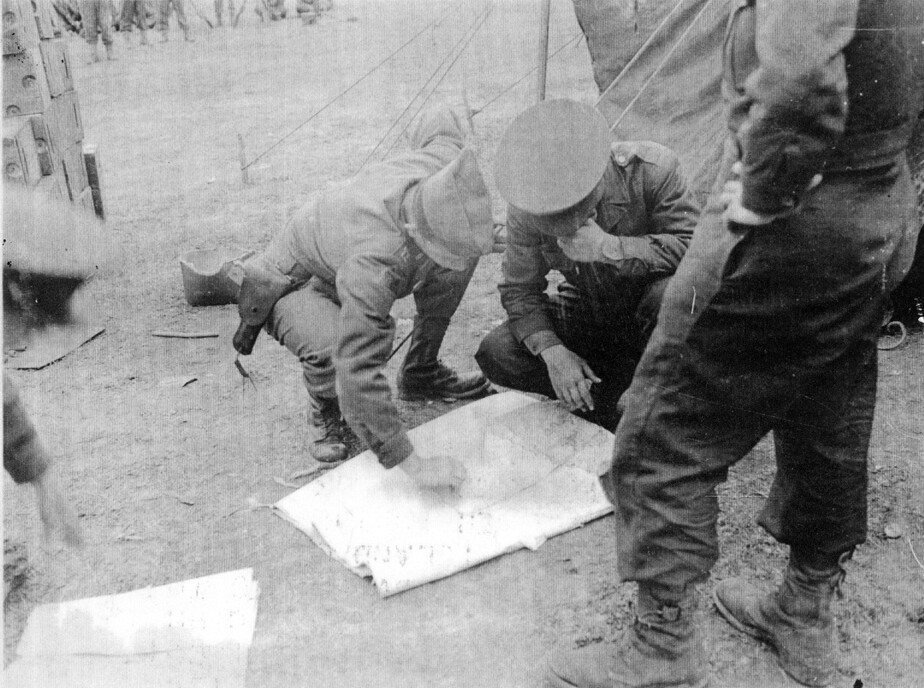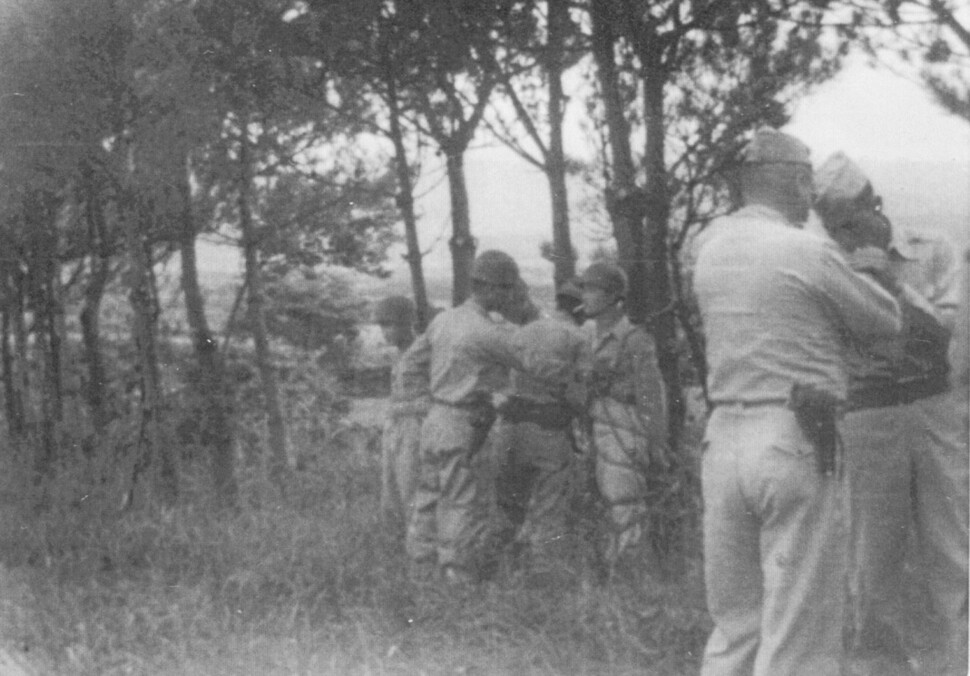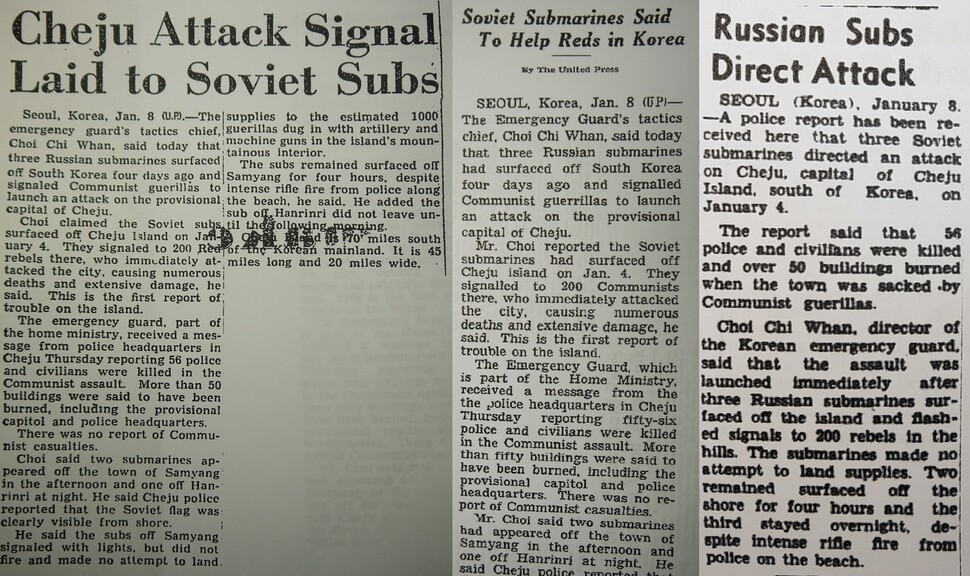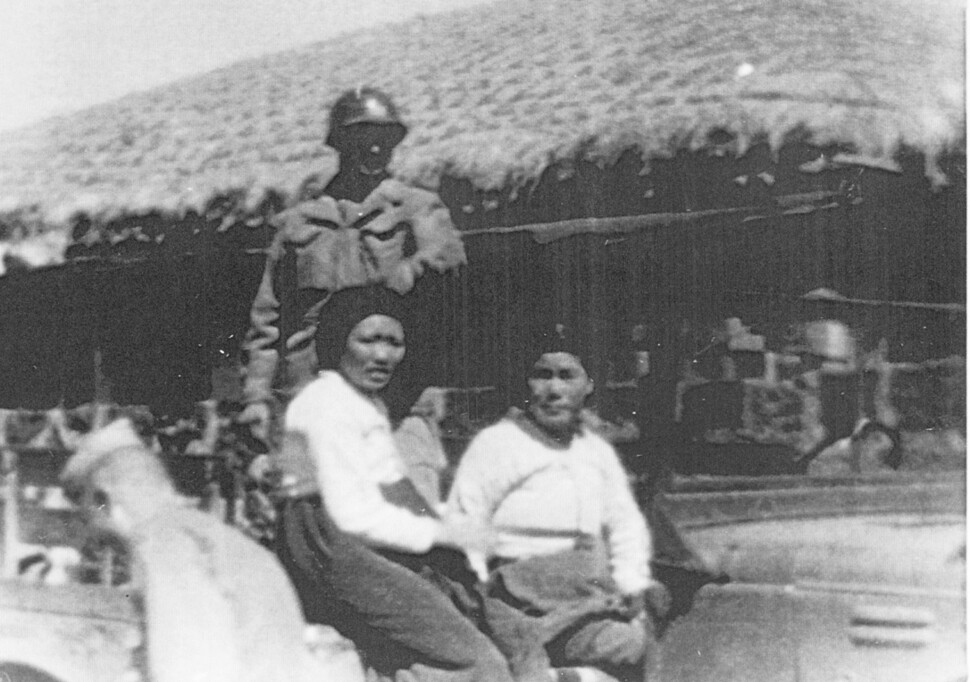hankyoreh
Links to other country sites 다른 나라 사이트 링크
[Special Feature Series: April 3 Jeju Uprising, Part III] US culpability for the bloodshed on Jeju Island

Visitors to the Jeju April 3 Peace Memorial in Jeju City’s Bonggae neighborhood on Mar. 24 finished their stop by leaving signatures in a book calling for the US and UN to undertake responsible measures and issue an apology. Since Oct. 2017, around 50,000 people have taken part in the “100,000-person signature campaign” by the Association for the Bereaved Families of 4/3 Victims, the Pan-National Committee for the 70th Anniversary of Jeju April 3, the Jeju Council, and other groups to call for “responsible measures” from the US and UN on the events of the uprising. Why are they demanding an apology from the US?
Shadows of the Cold War
“Jeju residents suffered tremendous loss of life and property under the cart wheels of history driven by the international Cold War and division of the [Korean] nation.” In an apology for the events of the Jeju April 3 Uprising during a visit to the island on Oct. 31, 2003, then-President Roh Moo-hyun made reference to the Cold War.
On Mar. 12, 1947, US President Harry Truman announced the so-called “Truman Doctrine” in response to a civil war in Greece. That same day in Seoul, the deputy director of the US Army Military Government in Korea’s (USAMGIK) police department, Choi Kyung-jin, declared that “ninety percent of Jeju Island residents have always had left-wing leanings.” The USFK Command’s intelligence staff (G-2) referred to Jeju as a “left-wing base” and a “Red island.”

In November of that year, a debate erupted in the UN between the US and Soviet Union over rumors that the US was developing Jeju as a military base. As the Jeju Uprising escalated, the foreign press described the events as “similar to the Greek civil war” that inspired the Truman Doctrine; even the USFK Command was astonished, it claimed. A Jeju April 3 investigation report published by the South Korean government in 2003 referred to the “shared press perception at the time that the US-Soviet Cold War had been responsible for the horrendous events of April 3.”
John Merrill, a former Northeast Asia bureau director for the US State Department who wrote the 1975 paper “The Cheju-do Rebellion” – the first academic work anywhere on the topic – explained in an interview and email exchange that the US “viewed the Jeju Island incident through a Cold War lens, and did not take the local situation adequately into account.” Merrill described the Uprising as “connected with the Cold War context in the broad sense within Asia.”

US military advisors’ role during the Jeju Uprising
US military advisors were present in the National Defense Guard (the predecessor of the Republic of Korea Army) regiment stationed on Jeju during the April 3 Jeju Uprising. They provided advice on all areas of training, operations, and logistical support. A Hankyoreh reporter previously met, emailed, or exchanged letters with six reserve officers and former US military advisors who worked on Jeju Island and in Seoul between May and December 1948, when the uprising was escalating. All have since passed away, but in past press interviews they claimed to have no knowledge of massacres during their service period.
“Jeju Island was a lawful military operation zone posing a threat to the lawful government,” said an advisor with the regiment between May and August 1948.
“We sent the 11th Regiment led by Col. Park Jin-kyung to the mid-mountain region for operations,” the adviser added. “I didn’t see it for myself, but when the Guard saw a mob they would summarily execute some of its members.”
A battalion and regiment adviser between July and August explained, “My duty was to suppress the rebellion and wipe out the Communists. We conducted several mop-up operations across Jeju Island.”
An advisor stationed on the island during the scorched earth operation period between September and December 1948 even reported that “people inland were all regarded as the enemy, and residents were evacuated to coastal villages.”
“At the Guard’s meetings, the number of people killed was always higher than number of weapons seized. I said they had to show a weapon, but it was too difficult to communicate. I really was just an ‘advisor,’” the advisor said.
But the same advisor recalled, “While I sensed that innocent people were being killed, I don’t know anything about massacres.”
The advisors roundly rejected arguments assigning responsibility to the US. “It was battle between democracy and communism,” they claimed.

Direct and indirect US involvement
In contrast with what the Guard advisors stationed on Jeju recalled, members of the US military government (USAMGIK) leadership, military advisors, and US ambassadors were deeply involved in the events on the island. Reports by the USFK Command, counterintelligence unit, and Korean Military Advisory Group (KMAG), along with US embassy documents and Far East Command reports, show the US was fully aware of the events of the Jeju Uprising from their beginnings through their escalation and conclusion.
With a general election scheduled for May 10, 1948, the US military administration encouraged suppression of the situation on Jeju with an inspection and orders from USFK Command’s Deputy Chief of Staff for Operations on Apr. 27–28. This was followed by a simultaneous inspection from William Dean, who served as the deputy to military governor Lt. Gen. John Hodge, along with the commander of the US 6th Infantry Division on Apr. 29. A second visit to Jeju by Dean for a meeting to discuss emergency countermeasures with South Korean leaders in the military government took place on May 5.
But when the general election took place on May 10, Jeju was home to the only two constituencies in South Korea to have voting cancelled, and the US military government took action directly. Two days later on May 12, the Far East Command dispatched the destroyer USS John R. Craig to Jeju. Around May 19, the commander of the 6th Infantry Division’s 20th Regiment, Col. Rothwell Brown, was sent to Jeju as supreme military commander. The events occurred ahead of a re-election on June 23. In an interview with one journalist, an advisor at the time said Brown was “placed in charge of all Korean National Guard forces and police on Jeju Island.”
Speaking in an early June conference with reporters after taking command of operations, Brown said, “I’m not interested in the cause of the uprising. My mission is to crack down only.” But the election was indefinitely postponed. Brown subsequently sent a letter to the 6th Infantry Division leader claiming Jeju had been organized into a communist base. April 3 Uprising researchers said it was this perception that made Jeju a target for annihilation.
A team of US envoys led by the members of the US Provisional Military Advisory Group (PMAG) and the US ambassador to South Korea was also deeply involved in the events on Jeju after the Republic of Korea government’s establishment on Aug. 15, 1948. At the height of the Jeju scorched earth campaign, Brigadier General William Lynn Roberts of the PMAG praised the operational capabilities of regiment commander Col. Song Yong-chan to Prime Minister Lee Beom-seok and recommended broadly publicizing the operation’s outcome. US military reconnaissance aircraft pilots aided the operation by providing the 9th Regiment of the Korean National Guard with details on the combat situation and the gathering sites of armed groups.
While this was happening, the foreign press devoted major coverage in Jan. 1949 to accounts that Soviet submarines and ships had been seen around the Jeju coast. The New York Times published a Jan. 9 article titled “Soviet Submarines Said to Help Reds in Korea.” That article and another the same day by the Washington Post reported that three Soviet submarines had appeared on the Jeju coast and sent an attack signal. The story received widespread coverage in the US, Southeast Asian, and Australian press, but no evidence has yet emerged to substantiate the claims.
On Apr. 9 of the same year, US ambassador to South Korea John Muccio told the State Department that Jeju had been chosen as a major stage for the Soviets to wage terrorist attacks on South Korea, claiming with certainty that Soviet agents were infiltrating the island with ease. Researchers have concluded the reports and US perceptions were an attempt to influence global opinion in the early Cold War era, presenting Jeju Island as a site of direct conflict between the US and Soviet Union.
Pushing for active US aid during a Cabinet meeting on Jan. 21, 1949, President Rhee Syng-man declared, “We need to express the sanctity of the law by eradicating factions on Jeju Island and in South Jeolla and suppressing them through brutal means.” At another Cabinet meeting on Jan. 28, he said the Jeju Island situation had “produced a positive outcome with the deployment of the US Navy.”
Recently discovered documents support Rhee’s claims at the time. A US military document uncovered by a Hankyoreh reporter at Japan’s National Diet Library confirmed that the US Navy did visit Jeju Island after his statement.
Another document drafted on Feb. 2, 1949, by a US Far East Command support group reported that Rhee, Muccio, and Roberts were present at a Jan. 24 banquet held on a warship while three US Navy vessels were visiting Incheon. The document also reported Muccio as consulting on the Jeju visit and amending plans after the South Korean government expressed its wish to have US Navy vessels visit the island.
The ships called at Jeju for just over three hours on Jan. 25 for meetings with US military advisors – providing evidence of coordination between the US and the Rhee administration. The US military and embassy officials’ interest in and opinions on the suppression effort in Jeju continued afterwards as well.

Holding the US accountable
The South Korean government’s recent investigation report indicated that the US military administration and USFK Military Advisory Group “cannot be free from responsibility” in connection with “mass loss of life.” Bruce Cumings, a University of Chicago chair professor and author of “The Korean War: A History,” affirmed the US’s responsibility to reporters last June while visiting to accept the Jeju April 3 Peace Prize.
“The US military government legally controlled South Korea for three years from 1945, and it controlled the military and police after that through operational control over the South Korean military,” he said.
John Merrill said that the Jeju Uprising “happened at a time during the US military government when cooperation with the Soviet Union was breaking down and the Cold War was setting in.”
He went on to hold the US responsible for events before the Republic of Korea government’s establishment and the Rhee administration responsible for those after.
“US military advisors were on Jeju Island for the duration of the April 3 Jeju Uprising,” he said. “Advisors held direct command responsibility before the Republic of Korea government was established. But after the Republic of Korea government was formed, the Rhee Syng-man administration’s policies were another factor.”
The Pan-National Committee for the 70th Anniversary of Jeju April 3 and other groups described the incident as a “massacre of civilians at a time when the US military administration was in control.”
“The US needs to acknowledge responsibility, apologize, and undertake corresponding measures for the slaughter of April 3,” the groups argued, adding that the UN “also needs to investigate and take [separate] measures.” Signatures for the campaign are being collected in Jeju and Seoul, as well as online from other parts of South Korea and the world.
By Heo Ho-joon, Jeju correspondent
Please direct questions or comments to [english@hani.co.kr]

Editorial・opinion
![[Column] Has Korea, too, crossed the Rubicon on China? [Column] Has Korea, too, crossed the Rubicon on China?](https://flexible.img.hani.co.kr/flexible/normal/500/300/imgdb/original/2024/0419/9317135153409185.jpg) [Column] Has Korea, too, crossed the Rubicon on China?
[Column] Has Korea, too, crossed the Rubicon on China?![[Correspondent’s column] In Japan’s alliance with US, echoes of its past alliances with UK [Correspondent’s column] In Japan’s alliance with US, echoes of its past alliances with UK](https://flexible.img.hani.co.kr/flexible/normal/500/300/imgdb/original/2024/0419/2317135166563519.jpg) [Correspondent’s column] In Japan’s alliance with US, echoes of its past alliances with UK
[Correspondent’s column] In Japan’s alliance with US, echoes of its past alliances with UK- [Editorial] Does Yoon think the Korean public is wrong?
- [Editorial] As it bolsters its alliance with US, Japan must be accountable for past
- [Guest essay] Amending the Constitution is Yoon’s key to leaving office in public’s good graces
- [Editorial] 10 years on, lessons of Sewol tragedy must never be forgotten
- [Column] A death blow to Korea’s prosecutor politics
- [Correspondent’s column] The US and the end of Japanese pacifism
- [Guest essay] How Korea turned its trainee doctors into monsters
- [Guest essay] As someone who helped forge Seoul-Moscow ties, their status today troubles me
Most viewed articles
- 1[Column] The clock is ticking for Korea’s first lady
- 2After 2 months of delayed, denied medical care, Koreans worry worst may be yet to come
- 3[Column] Has Korea, too, crossed the Rubicon on China?
- 4US overtakes China as Korea’s top export market, prompting trade sanction jitters
- 5[Correspondent’s column] In Japan’s alliance with US, echoes of its past alliances with UK
- 6Hong Se-hwa, voice for tolerance whose memoir of exile touched a chord, dies at 76
- 7All eyes on Xiaomi after it pulls off EV that Apple couldn’t
- 8[News analysis] After elections, prosecutorial reform will likely make legislative agenda
- 9More South Koreans, particularly the young, are leaving their religions
- 10John Linton, descendant of US missionaries and naturalized Korean citizen, to lead PPP’s reform effo